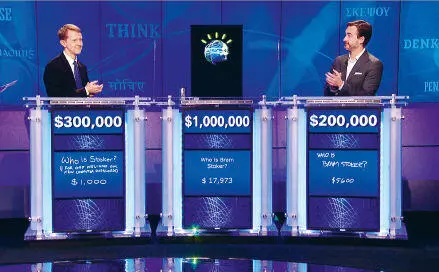Indeed, if we forbid humans to drive taxis and cars altogether, and give computer algorithms monopoly over traffic, we can then connect all vehicles to a single network, and thereby make car accidents virtually impossible. In August 2015, one of Google’s experimental self-driving cars had an accident. As it approached a crossing and detected pedestrians wishing to cross, it applied its brakes. A moment later it was hit from behind by a sedan whose careless human driver was perhaps contemplating the mysteries of the universe instead of watching the road. This could not have happened if both vehicles were steered by interlinked computers. The controlling algorithm would have known the position and intentions of every vehicle on the road, and would not have allowed two of its marionettes to collide. Such a system will save lots of time, money and human lives – but it will also do away with the human experience of driving a car and with tens of millions of human jobs. 4
Some economists predict that sooner or later, unenhanced humans will be completely useless. While robots and 3D printers replace workers in manual jobs such as manufacturing shirts, highly intelligent algorithms will do the same to white-collar occupations. Bank clerks and travel agents, who a short time ago were completely secure from automation, have become endangered species. How many travel agents do we need when we can use our smartphones to buy plane tickets from an algorithm?
Stock-exchange traders are also in danger. Most trade today is already being managed by computer algorithms, which can process in a second more data than a human can in a year, and that can react to the data much faster than a human can blink. On 23 April 2013, Syrian hackers broke into Associated Press’s official Twitter account. At 13:07 they tweeted that the White House had been attacked and President Obama was hurt. Trade algorithms that constantly monitor newsfeeds reacted in no time, and began selling stocks like mad. The Dow Jones went into free fall, and within sixty seconds lost 150 points, equivalent to a loss of $136 billion! At 13:10 Associated Press clarified that the tweet was a hoax. The algorithms reversed gear, and by 13:13 the Dow Jones had recuperated almost all the losses.
Three years previously, on 6 May 2010, the New York stock exchange underwent an even sharper shock. Within five minutes – from 14:42 to 14:47 – the Dow Jones dropped by 1,000 points, wiping out $1 trillion. It then bounced back, returning to its pre-crash level in a little over three minutes. That’s what happens when super-fast computer programs are in charge of our money. Experts have been trying ever since to understand what happened in this so-called ‘Flash Crash’. We know algorithms were to blame, but we are still not sure exactly what went wrong. Some traders in the USA have already filed lawsuits against algorithmic trading, arguing that it unfairly discriminates against human beings, who simply cannot react fast enough to compete. Quibbling whether this really constitutes a violation of rights might provide lots of work and lots of fees for lawyers. 5
And these lawyers won’t necessarily be human. Movies and TV series give the impression that lawyers spend their days in court shouting ‘Objection!’ and making impassioned speeches. Yet most run-of-the-mill lawyers spend their time going over endless files, looking for precedents, loopholes and tiny pieces of potentially relevant evidence. Some are busy trying to figure out what happened on the night John Doe got killed, or formulating a gargantuan business contract that will protect their client against every conceivable eventuality. What will be the fate of all these lawyers once sophisticated search algorithms can locate more precedents in a day than a human can in a lifetime, and once brain scans can reveal lies and deceptions at the press of a button? Even highly experienced lawyers and detectives cannot easily spot deceptions merely by observing people’s facial expressions and tone of voice. However, lying involves different brain areas to those used when we tell the truth. We’re not there yet, but it is conceivable that in the not too distant future fMRI scanners could function as almost infallible truth machines. Where will that leave millions of lawyers, judges, cops and detectives? They might need to go back to school and learn a new profession. 6
When they get in the classroom, however, they may well discover that the algorithms have got there first. Companies such as Mindojo are developing interactive algorithms that not only teach me maths, physics and history, but also simultaneously study me and get to know exactly who I am. Digital teachers will closely monitor every answer I give, and how long it took me to give it. Over time, they will discern my unique weaknesses as well as my strengths. They will identify what gets me excited, and what makes my eyelids droop. They could teach me thermodynamics or geometry in a way that suits my personality type, even if that particular way doesn’t suit 99 per cent of the other pupils. And these digital teachers will never lose their patience, never shout at me, and never go on strike. It is unclear, however, why on earth I would need to know thermodynamics or geometry in a world containing such intelligent computer programs. 7
Even doctors are fair game for the algorithms. The first and foremost task of most doctors is to diagnose diseases correctly, and then suggest the best available treatment. If I arrive at the clinic complaining about fever and diarrhoea, I might be suffering from food poisoning. Then again, the same symptoms might result from a stomach virus, cholera, dysentery, malaria, cancer or some unknown new disease. My doctor has only five minutes to make a correct diagnosis, because this is what my health insurance pays for. This allows for no more than a few questions and perhaps a quick medical examination. The doctor then cross-references this meagre information with my medical history, and with the vast world of human maladies. Alas, not even the most diligent doctor can remember all my previous ailments and check-ups. Similarly, no doctor can be familiar with every illness and drug, or read every new article published in every medical journal. To top it all, the doctor is sometimes tired or hungry or perhaps even sick, which affects her judgement. No wonder that doctors often err in their diagnoses, or recommend a less-than-optimal treatment.
Now consider IBM’s famous Watson – an artificial intelligence system that won the Jeopardy! television game show in 2011, beating human former champions. Watson is currently groomed to do more serious work, particularly in diagnosing diseases. An AI such as Watson has enormous potential advantages over human doctors. Firstly, an AI can hold in its databanks information about every known illness and medicine in history. It can then update these databanks every day, not only with the findings of new researches, but also with medical statistics gathered from every clinic and hospital in the world.

IBM’s Watson defeating its two humans opponents in Jeopardy! in 2011.
© Sony Pictures Television.
Secondly, Watson can be intimately familiar not only with my entire genome and my day-to-day medical history, but also with the genomes and medical histories of my parents, siblings, cousins, neighbours and friends. Watson will know instantly whether I visited a tropical country recently, whether I have recurring stomach infections, whether there have been cases of intestinal cancer in my family or whether people all over town are complaining this morning about diarrhoea.
Thirdly, Watson will never be tired, hungry or sick, and will have all the time in the world for me. I could sit comfortably on my sofa at home and answer hundreds of questions, telling Watson exactly how I feel. This is good news for most patients (except perhaps hypochondriacs). But if you enter medical school today in the expectation of still being a family doctor in twenty years, maybe you should think again. With such a Watson around, there is not much need for Sherlocks.
Читать дальше
Конец ознакомительного отрывка
Купить книгу













